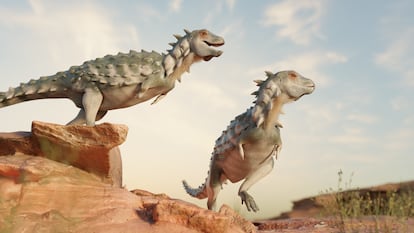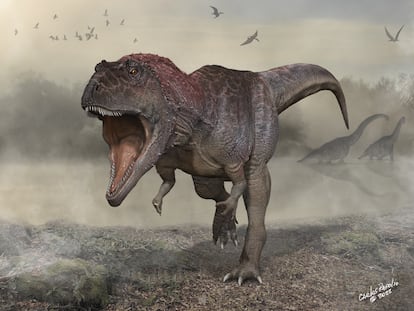The strange, armored dinosaurs that once populated South America
Stegosaurus’ earliest ancestors survived even after the Jurassic period and on a continent where their presence was previously unknown

About 100 million years ago, Patagonia was home to one of the largest carnivores that has ever existed: the Giganotosaurus carolinii. Between 39 and 42-feet-long and weighing nearly seven tons, this dinosaur was somewhat larger than even the mythical Tyrannosaurus rex. In fact, the two go up against each other in the Jurassic World movie saga.
In 1993, amateur fossil hunter Rubén Carolini discovered the first fossil of this lethal predator. And, in the 30 years since, Argentine Patagonia has become a mecca for paleontological research and scientific tourism. Considered to be a sort of dinosaur factory, the region has the most important paleontological collection in South America, where more than 30 new types of dinosaurs from the late-Cretaceous period — between 90 and 100 million years ago — have been discovered. In the middle of the desert landscape, museums dedicated to these prehistoric reptiles flourish. Meanwhile, fabulous discoveries continue to be made in the area, constantly changing what we think about the evolution of dinosaurs on the continent of South America.
The latest of these surprising finds is the new species named Jakapil kaniukura, which means “stone crest” or “shield bearer” in the ancestral languages of northern Argentine Patagonia. This armored dinosaur was no bigger than a domestic dog. Less than five-feet-tall and weighing between eight and 15 pounds, it was a herbivore. It also had much shorter front legs than hind legs, which indicates that it could run semi-upright, making it easier to flee from the fearsome Giganotosaurus, a fellow inhabitant of Patagonia.
The discovery of this species begins a new genus within the Thyreophora, the group of plant-eating dinosaurs characterized by the armor that covers the dorsal and upper part of the reptilian body. The best-known of this genus is the Stegosaurus — with pentagonal plates on a spine topped with thick spikes — as well as the Ankylosaurus, covered in a spiny carapace with a club at the tip of its tail.
Until recently, it was thought that these armored dinosaurs —who arose during the Jurassic period, between 145 and 200 million years ago — lived on the supercontinent of Laurasia, a huge landmass made up of present-day North America, Europe and China. Evolution led them to be quadrupeds: only the most primitive walked on two legs, like the Scutellosaurus. The discovery of the Jakapil, however, changes this story in three fundamental ways. We now know that Thyreophora continued to exist for a very long time after the Jurassic period (until the late-Cretaceous period) and spread to Gondwana, the supercontinent that contains present-day South America and Africa. We can also reason that this lineage probably underwent an evolutionary reduction of its front legs, as happened to other species, such as the Tyrannosaurus and the Giganotosaurus.
This new species lived in the hostility of the ancient Kokorkom desert, located in the current paleontological area of La Buitrera, in the Argentine province of Río Negro. There, all living things were thorny and hard, including the small Jakapil. To survive in this environment, it developed a high and robust jaw, which allowed it to eat whatever it found: seeds, succulent plants and even wood. Adorned with a stone crest, this peculiar jaw could also have served as a weapon of seduction; although for now, this is only conjecture.
The description of this specimen was published in the journal Scientific Reports in 2022, by Argentine researchers Facundo Riguetti and Sebastián Apesteguía, from the Félix de Azara Natural History Foundation, the Maimónides University in Buenos Aires and the National Scientific and Technical Research Council (CONICET). The Spaniard Xabier Pereda, from the University of the Basque Country, was also involved in the discovery.
None of the researchers expected much when they found the first remains in 2013. But everything changed six years later. “They were kept in storage for a while, [as we thought that] they could be from another animal, because a particular type of terrestrial crocodile once roamed this area... Since there were so many remains, it took until 2019 to finish cleaning them. Then, we began to see that the material wasn’t a crocodile, but rather, had striking, rare characteristics that we hadn’t seen in any other animal from that period of time in South America. As [the remains] were being cleaned, our eyes were becoming more and more open,” recalls Riguetti, from the province of Río Negro, in a video call with Apesteguía and Pereda, phoning in from Buenos Aires and the Basque Country respectively.
For the Spanish researcher, this discovery has been astonishing, especially considering the age of the fossil. “It corresponds to a lineage that was believed to be relict (a remnant of an ecosystem in regression). It would have been more logical [had it come from] the Jurassic period. That it appeared from [the Cretaceous era] is a real surprise. Probably, in Argentina and wider South America, [these remains] will continue to appear,” Pereda predicts.
The Kokorkom, which means “desert of bones” in the Indigenous Tehuelche language, was an extension of dunes of about 400-square-miles, nearly the surface area of the city of Rome. On that golden field, most of the world’s largest dinosaur bones — such as those of the Giganotosaurus and the Futalognkosaurus — vanished, but the smaller fossils that Apesteguía has been dusting off for the past 25 years have largely remained hidden below. He explains that the excavation site of La Buitrera “has preserved small skeletons very well. Every little animal, such as lizards, mice and little dinosaurs, that died in the desert was covered by the sand, [meaning that] they weren’t eaten by any scavenger carnivore.”
The site is one of the jewels of paleontology, because the quality of its fossil preservation is exceptional. “Big dinosaurs are everywhere, but the little animals that lived in the shadow of the giants are much more difficult to find. Of course, this happens in other parts of the world, such as the Gobi Desert (in China). For this reason, we usually refer to La Buitrera as the South American Gobi,” Apesteguía jokes.
During that bygone era, reptiles flew through the sky, stalking small creatures that desperately sought shelter. The numerous traces of caves are current evidence of how they tried to hide from threats, which came not only from the air, but also from the ground, where gigantic carnivorous dinosaurs, legged snakes and terrestrial crocodiles roamed.
Apesteguía lauds this cunning nature: “The desert is for specialists. Not any animal could live there. Probably the big dinosaurs passed through the desert without being affected too much, because they had enough reserves of water and food to cross it without blinking.”
But the little ones had to manage in another way. And hiding wasn’t always an option for the Jakapil, so bipedalism (standing upright) gave it a chance to quicken its pace. The researcher narrates this scenario as if he were observing it: “This little animal is living in an arid, open environment, where it cannot hide, and the predators are infinitely larger. The defense mechanism cannot be to hide or fight. Fast dinosaurs such as this one can eat in the open, keep an eye on their surroundings, and run away as soon as they see a predator approaching. It’s a logical response for that time and place.”
When living conditions are harsh, the risk of dying is high. Being quick and thorny helps, but it’s not quite enough. For the species to survive, a large family is necessary. “In the Kokorkom [desert], there are many individual specimens from just a few species, [which is] precisely a characteristic of current deserts as well. We’re not going to find too many species there, but many individuals from a few species.” In La Buitrera, researchers have already discovered 400 or 500 specimens of sphenodontia, about 15 specimens of snakes with legs, as well as some turkey vultures. “We know that there are remains [of the Jakapil] in other places, so we assume that at least three or four more will contribute [to their complete] skeletons,” the paleontologist speculates.
The researchers plan to continue to analyze the teeth, legs and armor in detail, with the goal of better understanding how this vegetarian dinosaur lived and whether the bony plates were related to temperature regulation, self-defense, or courtship.
The mere appearance of this species has already transformed what was known about armored dinosaurs in terms of their expansion in time and space. This will lead to a review of the information available regarding other groups of dinosaurs.
“A bug that appears where we didn’t expect it changes a lot of things; it changes the context. In South America, the Thyreophora were practically unknown, or there was very little record of them, until the appearance of the Jakapil. This tells us that more discoveries could be expected, and not just from armored dinosaurs. Because if these animals [were living in this part of the world], it could easily mean that [other species] lived in this territory — we just didn’t know about it,” Riguetti notes with enthusiasm.
Sign up for our weekly newsletter to get more English-language news coverage from EL PAÍS USA Edition
Tu suscripción se está usando en otro dispositivo
¿Quieres añadir otro usuario a tu suscripción?
Si continúas leyendo en este dispositivo, no se podrá leer en el otro.
FlechaTu suscripción se está usando en otro dispositivo y solo puedes acceder a EL PAÍS desde un dispositivo a la vez.
Si quieres compartir tu cuenta, cambia tu suscripción a la modalidad Premium, así podrás añadir otro usuario. Cada uno accederá con su propia cuenta de email, lo que os permitirá personalizar vuestra experiencia en EL PAÍS.
¿Tienes una suscripción de empresa? Accede aquí para contratar más cuentas.
En el caso de no saber quién está usando tu cuenta, te recomendamos cambiar tu contraseña aquí.
Si decides continuar compartiendo tu cuenta, este mensaje se mostrará en tu dispositivo y en el de la otra persona que está usando tu cuenta de forma indefinida, afectando a tu experiencia de lectura. Puedes consultar aquí los términos y condiciones de la suscripción digital.
More information
Archived In
Últimas noticias
Half of Scotland is in the hands of 420 property owners
Pinochet’s victims grapple with José Antonio Kast’s rise in Chile
Reinhard Genzel, Nobel laureate in physics: ‘One-minute videos will never give you the truth’
From digital curfews to blocking apps: How technology experts protect their children online
Most viewed
- Pablo Escobar’s hippos: A serious environmental problem, 40 years on
- Reinhard Genzel, Nobel laureate in physics: ‘One-minute videos will never give you the truth’
- Why we lost the habit of sleeping in two segments and how that changed our sense of time
- Charles Dubouloz, mountaineering star, retires at 36 with a farewell tour inspired by Walter Bonatti
- The Florida Keys tourist paradise is besieged by immigration agents: ‘We’ve never seen anything like this’










































